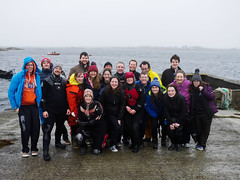The boat trailer bearings need regular maintenance and greasing. Maintenance is normally done by the equipment officers, but it’s not unheard of for bearings to fail whilst towing. This page tells you how to replace them.
Video guides to replacing trailer bearings
Here are a couple of excellent videos from etrailer.com on replacing trailer bearings:
Detailed instructions for replacing bearings
Tools and parts required
- Car jack
- Axle stands / blocks
- Wheel brace / wrench
- Rubber mallet (or hammer + block of wood in a pinch)
- Large flathead screwdriver
- Metal / wooden bar 1-1.5″ diameter (optional)
- Large adjustable wrench (for castellated nut, if stuck)
- Pliers – fine-pointed / circlip
- Pliers – heavy duty
- Grease gun and marine grease
- New bearings, races and seal
- Split pin for castellated nut (if old one can’t be reused)
Wheel removal
- Chock opposite wheel and apply handbrake
- Loosen nuts
- Release handbrake
- Jack up trailer
- Put axle stands / blocks under trailer and lower jack till trailer rests on them
- Remove wheel nuts and take wheel off
Hub & bearing protector removal
- Take off rubber cap from bearing protector
- Optionally (not essential for getting at bearings):
- Remove circlip from bearing protector (use fine-pointed pliers, or circlip pliers if you have them)
- Take out spring from bearing protector
- Take out seal (with grease nipple) & wipe clean
- Remove bearing protector cylinder (knock on side with rubber hammer, rotating hub till it comes out) & clean out
- Wipe off excess grease to get to castellated nut
- Remove split pin from castellated nut
- Unscrew castellated nut
- Remove hub (don’t get grease in outer part of hub as this will prevent brakes from working – degrease hub if you do!)
Bearings – removing and checking
-
- Lay hub flat with inside downwards. Take out top (i.e. outside) bearing (smaller one)
- Turn hub upside down and remove seal by prizing it out with a screwdriver & hammer
(seal will be destroyed in the process – fit a new one when reassembling) - Remove second bearing, clean & check for damage (as before)
- Clean out all old grease (don’t mix greases as this can lead to faster grease degradation)
- Check bearing for chips, discoloration, denting on cage. Replace bearing if damaged
Races – checking & removing
- Clean out all old grease from inside of hub
- If bearings look OK, then races will probably be OK too. Look & feel for damage, and check for discoloration
- If races need replacing, hammer out with hammer and screwdiver or wood / metal rod
- insert new race and hammer flush with hub. Then place old race on top and hammer in further – but not so far that old race can’t be removed!
Bearings, races – regreasing & replacement
- Apply new grease liberally to races
- Pack bearings with new grease:
- Put grease in palm of hand and press bearing into it, working whole way round
- Flip bearing and repeat
- Rotate individual bearings to work grease round them
- Put bearings into races
- Fit new seal on inner bearing – tap down with hammer until flush with hub
Hub and bearing protector refitting
- Screw castellated nut back on
(don’t overtighten – just put it back enough so split pin hole in nut lines up with hole in axle stub) - Replace split pin (use new one if need be) and bend ends to lock in place
- Refit bearing protector cylinder
- Insert grease nipple and outer rubber seal (circular ridge facing outwards)
- Insert spring and fit circlip over top
- Fill bearing protector with grease from gun
- Refit rubber cap
Wheel refitting
- Slot wheel back onto bolts
- Screw nuts in till hand tight
- Jack trailer up till axle stands / blocks can be removed
- Lower jack
- Apply handbrake
- Tighten wheel nuts




